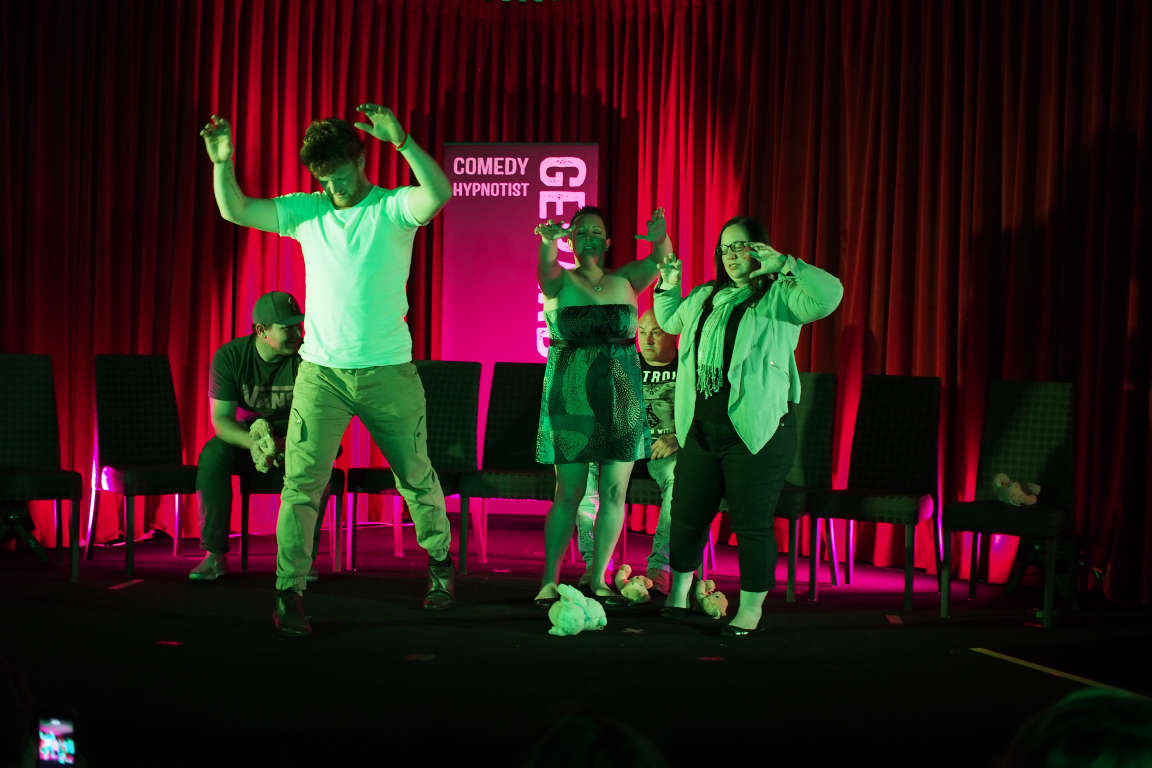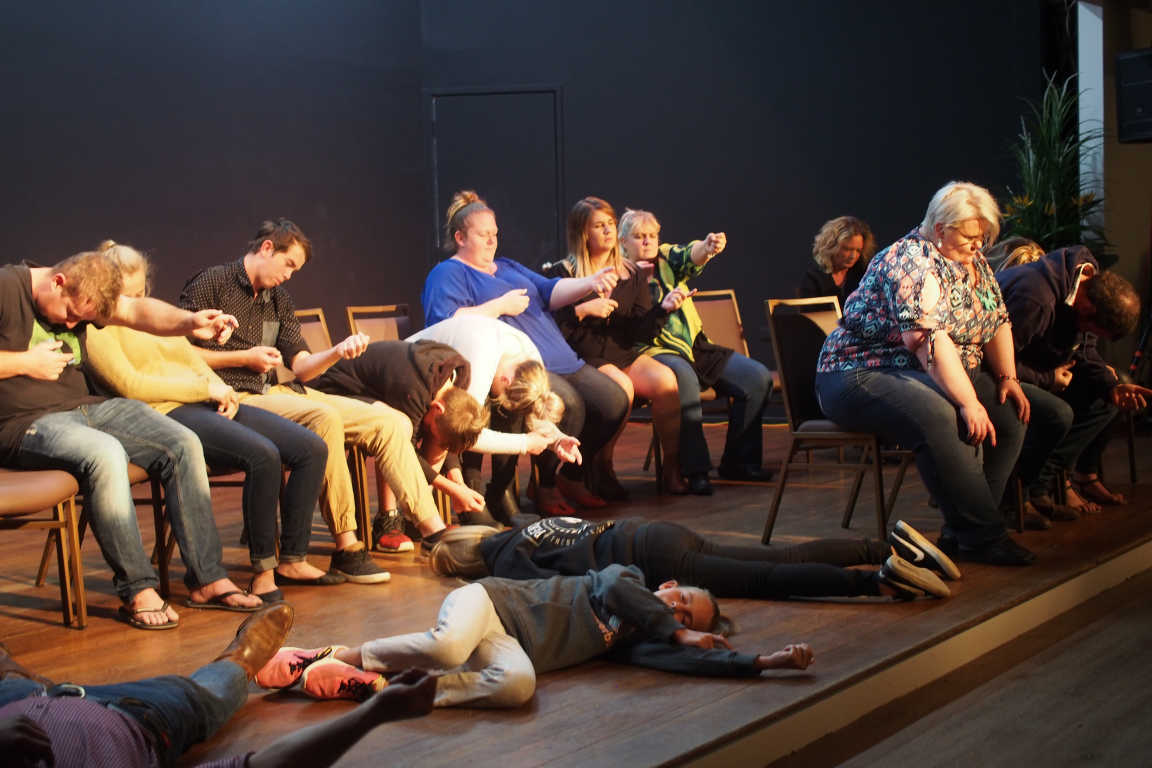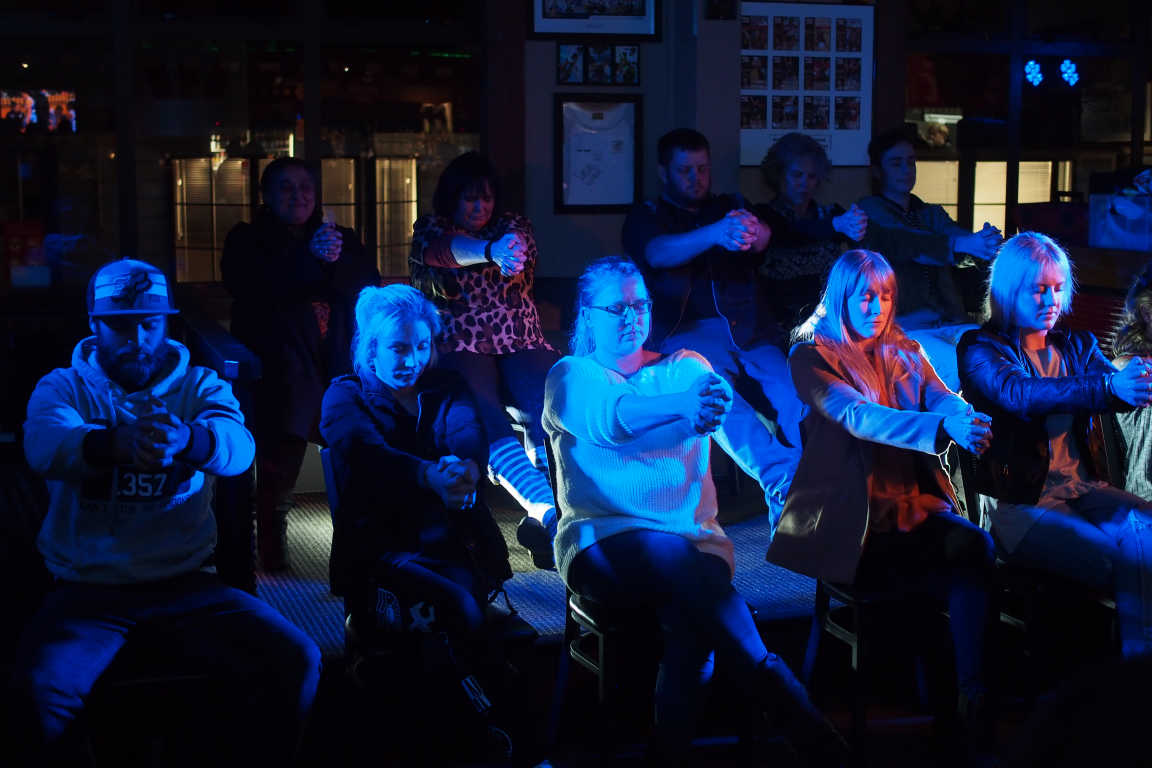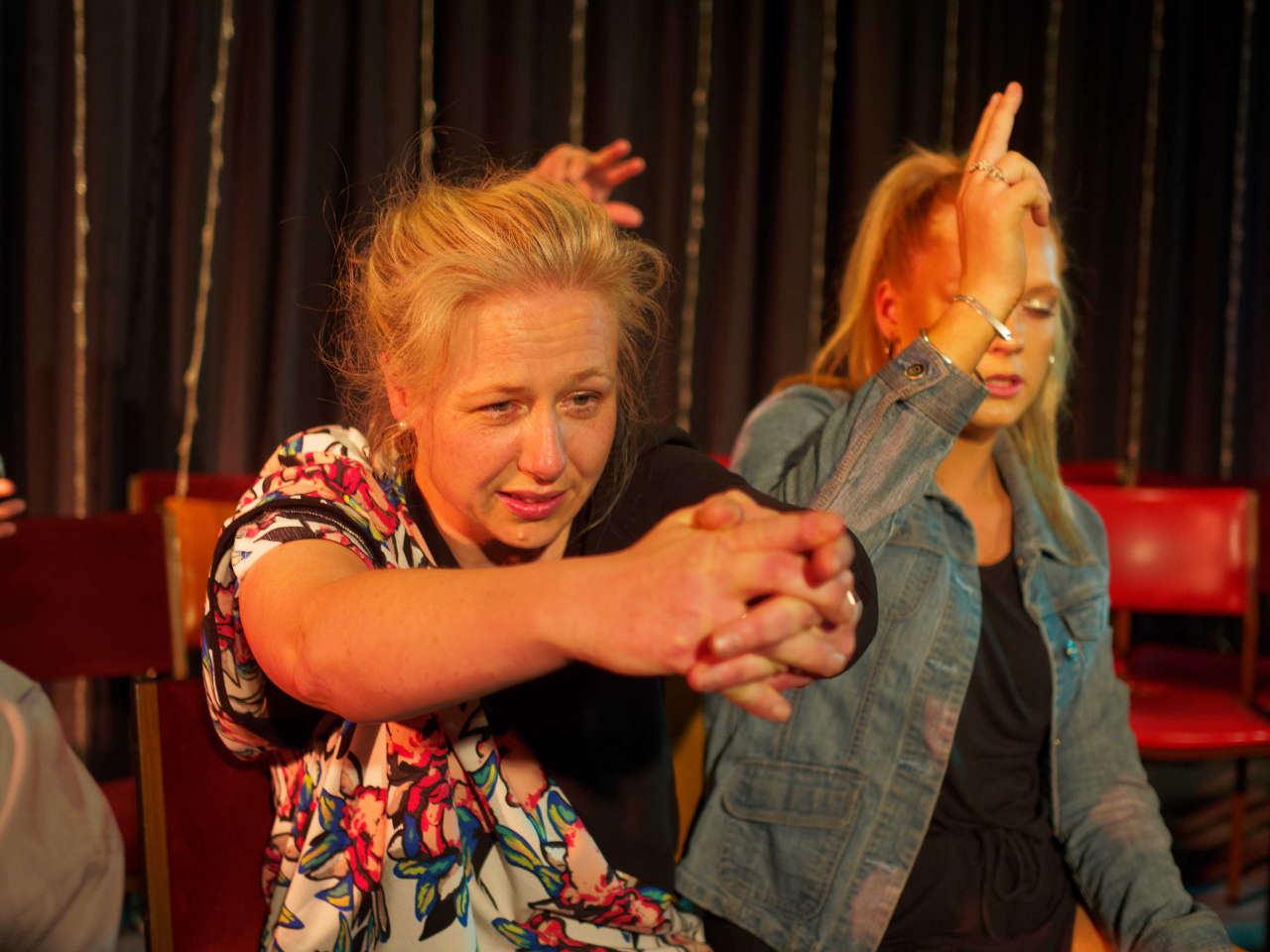How Does Stage Hypnotism Work?
Is Stage Hypnosis Real? What is real hypnosis?
Summary (TL;DR)
- Hypnosis is real: Wikipedia
- Stage hypnotists are good at selecting the most easily hypnotised subjects
- It is easy to get good volunteer subjects so fakes are not needed
- The Hypnotist will quickly dismiss unresponsive or troublesome people
- By carefully choosing suggestions the hypnotist can make the subjects more and more compliant
- Even though a few claim they weren’t “under” its obvious to the audience that they were doing things they wouldn’t normally do.
How Stage Hypnotism Works.
This article breaks the question down into several parts.
- Are the people on stage really hypnotized?
- Are they in on it?
- Are they set up in advance?
- Are they actors?
How does the hypnotist select subjects?
How does the hypnotist gain compliance?
Do stage hypnotists use any fakery or tricks?
What is it like being hypnotized?
- Do people know they are hypnotized?
- What does it look like to the hypnotist?
- What does it look like to the audience?
- What does it feel like for the subjects?
Is Hypnosis Real?
Short answer: yes. There’s a variety of peer reviewed scientific studies that verify that the state of hypnosis is a unique and genuine state of mind. For example Psychology Today The Truth About Hypnosis | Psychology Today. Hypnotic trance is a measurably different state of consciousness.
Not only that - it is common for people to experience hypnosis in one form or another many times in their lives without really knowing it.

Our knowledge of the mind and consciousness is not complete; there’s a lot more to discover. However our current knowledge indicates that for the most part everyone can be hypnotised provided they are willing and in the right state of mind (safe place, relaxed etc.), but that under hypnosis people generally cannot be compelled to act against their deeply held beliefs or moral code.
Some formal studies conclude that some people are “unable” to be hypnotised. But they simply demonstrate that those people were unable to be hypnotised by the people performing the study using the technique and script they tried. Such studies do not demonstrate that the person could never be hypnotised at all.
It frequently happens that a person who claims that they are unable to be hypnotised after failing to go into trance in a clinical hypnosis session then “goes under” at a stage show or corporate event where the contaxt and techniques are different.
One of the most difficult aspects of proving hypnosis is that it is partly science and partly an art. A big part of the teaching of hypnosis is how a good hypnotist changes their approach to hypnotising a subject based on how the subject is responding. See Sean Michael Andrews. This does not lend itself well to controlled trials where an unchanging scripted approach is usually needed.
Anyone under hypnosis can “snap out of it” at will, this is what prevents them acting against their conscience during a stage show or clinical hypnosis. This counters the fear some people have about losing control. Control is never lost, simply the will to exercise control is relaxed so that the subject beomes more open to suggestion without losing the ability to make their own choices.
Are The People on Stage Really Hypnotised? [Mostly Yes]
In the case of professional stage performers, the answer is “yes they are”. A competent hypnotist can and will hypnotise her volunteers quickly and deftly on stage with the audience looking on.
Being on stage having volunteered, and with everyone watching them, is itself a different state of mind for most people. The pressure of all that attention means they are more likely to focus on the process. This increases the chances of success for the hypnotist. Those who don’t focus are quickly dismissed.
The hypnotist will quickly work through the group of volunteers and dismiss the resistant, the uptight and the troublesome, keeping only those that are good hypnotic candidates, and are open to suggestion at that time, as noted by their willingness to follow instructions and their apparent willingness to ”giving it a go”.

Signs of Unsuitability
An obvious test for the hypnotist is how well the volunteers listen to and obey instructions prior to being hypnotised. A person who is partly or completely resistant will not act immediately on an instruction from the hypnotist. They will first think about it and then decide if they’ll act on it and to what degree.
By simply saying to the entire group of volunteers something like “please sit still and let me explain what’s going to happen next” the hypnotist can observe those who immediately relax and become attentive and note those who did not react immediately as being potentially unwilling or resistant.
The ability to notice the lag between suggestion and action is one of the tools that hypnotists use to sort out the hypnotised from those who try to fake it.
As the process of hypnotic induction advances, the responses of the volunteers will increasingly be driven by their subconscious minds, and the response will be correspondingly quicker and more complete.
Are They In On It? [No]
It is claimed by some skeptical people that the hypnotised volunteers on stage must be “in on it”. Their thinking seems to start from the belief that hypnosis is not real (it is) and therefore they seek an explanation for the antics of the subjects that does not involve hypnosis. This is one of the common myths about hypnosis.
If one insists that hypnosis cannot be real, then the obvious conclusion is that if they are not hypnotised would be that they must simply acting. And some people have gone so far as to suggest that the volunteers are in fact paid performers.
Are They Paid Actors? [LOL,No]
While I make a good living as a corporate entertainer doing comedy hypnotist shows, I can assure you that I do not get paid anywhere near enough to hire a dozen actors to work for me (even though actors are not well paid in general, I couldn’t pay even one or two). Anyone giving this notion a little thought will see that even if all the volunteers are not people you know - they’re still unlikely to be being paid.
However the best counter to this is when you witness the hypnotist hypnotise someone or several people that you already know. Or perhaps they will be entertaining at a corporate event, or a conference where the volunters are all people who work at the company and are attending that conference.
Are They Set Up In Advance? [No]
If the skeptic acknowledges that the paid actor scenario doesn’t stack up financially, they often suggest that the people are set up in advance in some other way.
For this to be true the skeptic must also believe that the hypnotist or their agent contacted the people covertly before the show and successfully recruited them to perform. Without anyone saying no or giving it away before or afterwards. That would be a truly remarkable achievement were it so.
Wouldn’t you tell your friends if someone had contacted you in advance and asked you to cheat in that way? I would. Suggesting that hypnotists have the ability to persuade a bunch of folks in advance in that way, with no leaks or exposure, actually suggests they are more skilful and persuasive than merely hypnotising genuine volunteers.
In a practical sense the author and most professional hypnotists arrive in town for our shows only hours before the event, and have no contact with the audience before they come into the theatre. We have neither the time nor the resources to canvass the area beforehand.
Are They Just Fakers? [No]
So the next skeptical position is to claim that the volunteers are just faking it for attention. Or that the hypnotist is good at selecting people who are willing to fake it.
To suggest that in a group of 40 people there are 12 who are able to be influenced in that way is very unlikely.
It is far simpler to take the next step and accept that hypnotists are good at getting ordinary people to behave very differently to their usual selves.
And that is what we do. You can verify that by going to a few smaller shows. When the size of the audience is small, you will see the hypnotist work quite hard to attract a good number volunteers, because they’ll have so few people to start with. Not every show turns out like a TV spectacular, however a small event with a group of friends and family can be amazing fun because every volunteer is known to the majority of the audience, and their actions make great social media material.
This is also the reason that many Hypnotists demand an audience size of 50+ or even 100+ before accepting a booking. (The author regularly performs with groups of 12 or 20 people and is unusual in this regard).
Do People Try to Fake It? [Yes]
That’s not to say that some folks don’t try to fake it on stage. But mostly they’re obvious and quickly dismissed. In the author’s experience they’re not that common either. Most people are too self conscious to remain on stage if not also hypnotised.
How Does the Hypnotist Select Subjects?
In any large group of people there will be some who are fairly easily hypnotised. And some who are keen or at least willing to do it.
During the introduction (aka the “pre talk”), the hypnotist sets the scene for the show, puts people at ease and sets some limits for who they will accept on stage, for example an age limit. They’ll explain that the process of hypnosis is simple and how it allows the persons subconscious mind to guide their actions in response to suggestions from the hypnotist.
Most hypnotist also perform a suggestibility test with the audience before seeking volunteers.
Suggestibility tests are simple routines that demonstrate both to the audience and the hypnotist the degree to which people are responding to hypnotic suggestion at that time.
By asking those who responded well to come up on stage the hypnotist has selected good candidates.
Another approach, one that I prefer, is simply to ask for volunteers and then perform the suggestibility test. This can lead to losing more people from stage as being unresponsive, but makes it totally clear to everyone that no subject was influenced to be on stage in any kind of underhanded way.

Being hypnotised is genuinely fun. It is not hard to convey that to a group of people and some will volunteer out of curiosity. With enough volunteers, there’ll always be a few good candidates and the show can build on those.
How Does the Hypnotist Build Compliance?
“Come up on stage”. “Please have a seat”. “Please move one chair over”. “Now listen carefully to what I am about to say”. Each of these suggestions is easy to follow, and builds on the prior ones. Few would resist such easy requests. Yet together they have the effect of building compliance, and the habit of unthinkingly doing what the hypnotist suggests.
The start of a show by any professional is filled with innocent requests, the combined effect of these is to condition the subjects to comply automatically with the directions of the hypnotist.
This is how it is done. There’s much more than the scope of this article allows about how to actually hypnotise. But the heart of the process is simply that by repeatedly responding to the requests of the hypnotist it can soon become an automatic and unconscious process.
So long as the person was willing at the outset, feels safe, and is not asked to do anything too extreme or immoral, they will continue to respond automatically.
Do Stage Hypnotists Use Any Fakery or Tricks? [No]
The majority of stage professionals use no fakery of any kind. However there will always be a few amateurs who, believing that hypnosis must involve fakery, will try to fake some or all of a show.
The author has never heard of anyone succeeding with that approach (see the reasons above why fakery is not practical). I know of only one person who even attempted it.
Really, no Tricks? [Misdirection, yes]
There are a few misdirections that hypnotists use - like magicians also do. These are tricks rather than fakery. The trick I have seen often used is to conduct a suggestibility test - such as having people lock their fingers together overhead, and then to say those who cannot separate them are easily hypnotised. While there is some truth in this, the real reason people cannot separate their fingers is physical in that case. It is a limit of the human body for most people, and the hypnotist is misdirecting them by saying they are responding to suggestion at that point.
What Is It Like Being Hypnotised?
Do People Know They Are Hypnotised? [Most Do]
Hollywood movies often portray hypnotised subjects as unknowing robot-like zombies. This can lead to some confusion on the part of the subjects who become hypnotised but find the experience different from their expectations.
Knowing you are hypnotised depends on your ability to recognise that you are in a different mental state, and on what you think it should feel like to be hypnotised. If you have a strong but mistaken belief the you become robot-like, then you might not be able to match your actual experience to what you expected. In other words, you might be hypnotised but think that you are not. So what does it feel like?
What Does It Feel Like For The Subjects?
When they find themselves doing surprising things on stage most subjects acknowledge that they are indeed hypnotised. Many will afterwards report that they “knew what was going on the whole time, but couldn’t seem to make themselves stop”. Most would agree that could could have snapped out of it if they had really tried to, but didn’t even want to try. This is what it feels like for most subjects.
Some people will argue that they aren’t hypnotised because they remained aware of what is going on. It differs so much from what they expect that they deny being in a trance, even though the physiological signs are there, and they have clearly been responding to the hypnotist. They usually then will say they could have stopped at any time but didn’t. This is in fact the same experience as those who know they are under hypnosis.
Some subjects, a minority, have no memory of their time in trance.
What Does It Look Like to the Hypnotist?
From the hypnotist’s point of view, other than noting reactions and compliance as mentioned above, there are a number of other simple ways to distinguish the hypnotised from the merely compliant and those who are faking.
Facial Blood Flow
Hypnotised subjects flush and have higher facial blood flow. It varies between individuals. Some go a bit redder in the face, others have fuller lips when in trance.
Tears (Lachrymosity)
Hypnotised people often have watery eyes.
Muscle Tension
A good trance is often indicated by a higher degree of muscle relaxation than a person can easily adopt while conscious. If the hypnotist picks up a person’s arm by the wrist and shakes it about, a conscious person will often show a slight tension or resistance, and someone faking will often try to “go along with” the movement by moving their arm deliberately - this muscle activity either aiding or resisting the hypnotist is a clue regarding how deep the person is in a trance.

Opposition
One of the more dramatic ways a hypnotist can verify that a person is in a trance (and demonstrate that to the audience and the subject themselves) is to command the person to act in a way contrary to their obvious intentions.
The author frequently employs this technique with volunteers who claim that they are “not hypnotised” and attempt to get up and leave the stage. Seeming to go along with them I will help them off the stage by holding their arm and then simply say “sleep” as they reach the bottom of the stage steps. If I have to catch them as they flop to the floor, everyone is convinced.
What Does It Look Like to the Audience
Demonstrations such as the above are clear convincers. And for community events, simply seeing someone you know acting out of character to their usual selves is very convincing.
However there are some other cases where it is less clear to the audience.
The Open Eyed Trance Subject
While many people have their eyes closed during the induction and keep them that way, some trance subjects open their eyes and look around.
To the audience they may seem completely awake - but the hypnotist might know they are in a trance (see the section above).
There is frequently some debate after the show as to who was really hypnotised and to what degree. This is unavoidable given that people generally know very little about hypnosis but have high expectations of what they think it should look like.
Contrary and Odd Reactions (and non-reactions)
The other area that can confuse is where a subject reacts completely differently to what the audience (and sometimes the hypnotist) expects. This is sometimes because that they misheard or misunderstood the suggestion (people have no better hearing or comprehension in trance than when fully conscious), or if they simply have an odd way of interpreting an idea.
In some cases, where the subject is confused they’ll simply not respond at all.
However whether acting differently or not at all they may remain in a deep trance state nonetheless.
The case where a person does the opposite of what is suggested is an odd one and uniquely funny if the hypnotist catches it near the beginning.
A skilful hypnotist can employ a person’s determined opposition to cause them to go into a deeper trance (don’t relax!) and then play that up in gags. A suggestion such as “Everyone on stage will laugh except this fellow here. . . “ sets the person in a double bind - if they don’t laugh they are following the suggestion, but if they do laugh, they also appear to be following the suggestion. Either way - the crowd will laugh at the result.
Conclusion
Stage hypnosis is a real phenomena - and the majority of performers are genuinely skilled people, who hypnotise real volunteers without any pre-arrangements.
A few people (performers and subjects) may try to fake it but they are obvious and people will soon see through it.
Verify This Yourself
Go and see a few shows. . .
